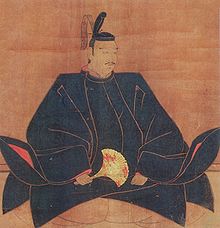- Ii Naomasa
-
Ii Naomasa 
Lord of Takasaki In office
1590–1600Preceded by none Succeeded by Sakai Ietsugu Lord of Hikone In office
1600–1602Preceded by none Succeeded by Ii Naokatsu Personal details Born March 4, 1561
Tōtōmi Province, JapanDied March 24, 1602 (aged 41)
Edo, JapanNationality Japanese Ii Naomasa (井伊 直政, March 4, 1561 – March 24, 1602) was a general under the Sengoku period Daimyo, and later Shogun, Tokugawa Ieyasu.[1] He is regarded as one of the Four Guardians of the Tokugawa along with Honda Tadakatsu, Sakakibara Yasumasa and Sakai Tadatsugu.
Contents
Early life
Ii Naomasa was born in Hōda Village of Tōtōmi Province. His family, like Tokugawa's, had originally been retainers of the Imagawa clan, but following the death of the clan's leader, Imagawa Yoshimoto, in the Battle of Okehazama (1560), confusion and general chaos ensued. Naomasa's father, Naochika, was falsely convicted of treason by Yoshimoto's paranoid successor, Imagawa Ujizane, and was subsequently killed. Naomasa, then a very small child, was personally lucky to escape his father's fate and was later taken in by the Tokugawa.[1]
Naomasa the General
Ii Naomasa joined the ranks of the Tokugawa clan in the mid-1570s, rising swiftly through the ranks to eventually become the master of a sizable holding in Ōmi Province, following the Battle of Sekigahara (1600).[1] His court title was Hyōbu-dayū.
Naomasa initially garnered mass attention at the Battle of Nagakute (1584), commanding around three thousand musketeers with distinction. His finest hour was to come at the Battle of Sekigahara, where his unit outpaced those of other generals such as Fukushima Masanori, drawing the "first blood" of that battle. However, as the fighting was dying down, Naomasa was shot and wounded by a stray bullet during his attempt to prevent Shimazu Yoshihiro's getaway, a wound from which he would never fully recover. The wound also prevented his personal involvement in quelling the last vestiges of the anti-Tokugawa faction in the coming months.[1]
The units Naomasa commanded on the battlefield were notable for being outfitted almost completely in blood-red armour for psychological impact, a tactic he adopted from Yamagata Masakage, one of Takeda Shingen's generals.[1] As such, his unit became known as the "Red Devils", a nickname he shared. It is also rumored, although never confirmed, that Naomasa would sometimes wear a monkey mask into battle, including at Sekigahara.
Death and legacy
Ii Naomasa's premature death in 1602 has been widely blamed on the wound he received at Sekigahara. Naomasa was highly regarded by Tokugawa Ieyasu, so it is no surprise that his sons Naotsugu and Naotaka succeeded him in his service and title. However, Naotsugu managed to anger Tokugawa by refusing to take part in his campaign to reduce the Toyotomi clan stronghold at Osaka. Nonetheless, the Ii remained influential in Japanese politics throughout the Edo period.
Naomasa is often characterized as the opposite of Ieyasu's other great general, Honda Tadakatsu. While both were fierce warriors of the Tokugawa, Tadakatsu survived countless battles without ever suffering an injury, while Naomasa is often depicted as enduring many battle wounds, but fighting through them.
Naomasa's sets of armor are all preserved within Hikone Castle and are accessible for viewing.
Ii Naomasa in Popular Culture
See People of the Sengoku period in popular culture.
Notes
Preceded by
noneLord of Takasaki
1590–1600Succeeded by
Sakai IetsuguPreceded by
noneLord of Hikone
1600–1602Succeeded by
Ii NaokatsuExternal links
- Ii family information (in Japanese)
- Painting and brief bio of Naomasa (in Japanese)
- Information on Naomasa, including images of his flag, battle standard, and armor (in Japanese)
Wikimedia Foundation. 2010.

